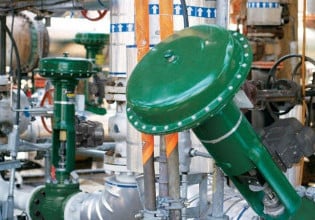Storing Heat in a Big Thermos Helps Reduce Greenhouse Gas Emissions
Storing energy from renewable sources and excess heat from industrial processes can make district heating systems more efficient and less polluting.
Storing energy produced by renewable and other sources is one of the keys to a future with zero greenhouse gas (GHG) emissions. Wind and solar are intermittent sources of energy and excess electricity that is generated on particularly sunny or windy days can be stored for future use. Expensive lithium-ion or flow batteries can be used to electrochemically store electricity produced from these renewable.
Another way to store intermittent renewable energy sources is to convert the electrical energy into heat, which can then be stored in large thermal energy storage facilities for a much lower cost. Such facilities, which act like a big thermos bottle, can also store heat created by gas-fired heat-only boilers or waste heat generated by a variety of industrial processes.

A huge storage tank in Berlin containing 14.8 million gallons of water can store heat energy for up to 13 hours. Image Courtesy of Vattenfall.
Storing Heat in Berlin
One such thermal energy storage facility has been built in Berlin’s Spandau district. The Swedish power company Vattenfall constructed a giant water tank that is almost 150 feet (45 meters) in diameter and holds 14.8 million gallons (56 million liters) of water.
Gas-fired heat-only boilers will be used to heat the water as high as 98 degrees C in the 200 megawatt (MW) system that can store up to 2,600 megawatt-hours (MWh) of energy. The insulated tank keeps the water hot for up to 13 hours. The goal is to replace the hard-coal-fired Unit C of the local power plant in Reuter, part of Vattenfall’s climate protection agreement with the City of Berlin toward a total phase-out of hard coal in Berlin by 2030.
The water storage tank is part of a district heating system to meet the heating needs of customer households. District heating systems use a centralized plant that produces hot water which is then distributed to households and businesses within a district. In addition to the heat-only gas-fired boilers, excess solar and wind energy can be converted into heat and used to add to the water-based thermal energy storage. Waste heat from industrial processes and even wastewater can also be harvested and stored in the system.
Finland Stores Heat Using Sand
Germany isn’t the only country where thermal energy storage projects are underway. In Finland, a new system has been developed that uses sand to store heat energy. Finnish company Polar Night Energy’s patented heat storage system provides heat for Vatajankoski’s district heating network in Kankaanpää.
The heat storage steel container is about 13 feet (4 meters) wide and 23 feet (7 meters) high and contains about a hundred tons of sand inside. Sand is durable and inexpensive—it can store a lot of heat in a small volume at about 500 to 600 degrees Celsius. The prototype heat storage system has 100 kW of heating power and 8 MWh of energy capacity.

In Finland, a prototype heat storage facility using sand has been more successful than expected. Image used courtesy of Polar Night Energy
Surprisingly Successful
In addition to storing excess energy from renewable sources, Vatajankoski uses waste heat recovered from data servers used for high-performance computing. The temperature of the 60-degree waste heat from the servers must be raised to 75 to 100 degrees before it is fed into the district heating storage system. In addition to providing district heating to the community, the pool of Kankaanpää’s swimming hall is heated by district heating from Vatajankoski.
“The construction of the storage went well, especially considering that the solution is completely new,” said Polar Night Energy’s Co-Founder and CTO Markku Ylönen in a company news release. “We managed to get everything in order despite some challenges and a short delay. We have already learned that our system has even more potential than we initially calculated. It’s been a positive surprise.”






